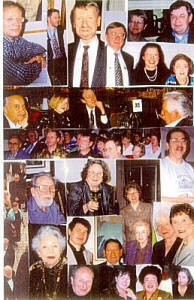|
The
Wagner Society |
|
|
|
FOR IMMEDIATE RELEASE Gotterdammerung at Dallas OperaMusic Hall, Dallas, TX, January 16, 2002
by Ed Flaspoehler, WSD © 2002 Wednesday night's Gotterdammerung at Dallas Opera was good. Not great. Just good. And highly entertaining. The sets and costumes by Argentineans Roberto Oswald and Anibal Lapiz were excellent, and the lighting superb. Dallas Opera has always had good lighting directors. This is the second go-round for these sets by Dallas Opera, which were introduced in 1985, and the designers have made several improvements in the visual presentation, including swimming Rheinmaidens and Walhallas that collapse convincingly. The singers were up to the task, and are, I suppose, what is on the world stage these days, but, in my opinion, were slightly under powered for the task at hand. George Gray as Siegfried has a rather tight tenor that he pushes around, but it never soars. He ran out of steam in the third act, the scene with the Rheinmaidens, but that is not unusual for tenors singing Siegfried. Wagner wrote his most difficult music here. Fortunately, he regained his vocal composure for Siegried's narrative and death in the next scene. Somewhat chunky in stature, Mr. Gray is not conventionally handsome in the traditional Germanic sense, and so some of the effect of "very strong, and very brave, and very handsome" was lost. Nevertheless, he manages to project a certain boyish charm and innocence as Siegfried that makes his characterization engaging. Frances Ginzer as Brunnhilde was excellent, but a bit cold. She got all the notes, and has a lovely timbre, but the passion just did not come across, at least for me. One of my voice teacher friends went back stage to get a hug afterwards, and proclaimed her superb. Ms. Ginzer is attractive, if slightly hefty, and so looked the part. She seems to be well endowed up front, but it may have been a push up bra built into the costume. Brunnhilde should be blond and buxom, and she filled the bill. The strongest singer in the cast was Eric Halverson as Hagen. He made himself the central character in this performance, the evil hub around which the plot, such as it is, turned. Not only did his full and rich bass voice soar when it needed to soar, but his coloration of the various emotions he portrayed made him a convincing villain. And he acted well, grimacing, and strutting, and cowering in turn. He was truly a standout, and was awarded the best applause at the end by the discriminating Wednesday night audience. Shirley Close was convincing as Gutrune, and Peter Weber gave an admirable performance as Gunther. The most interesting part of this whole event, however, was Graeme Jenkins, music director of Dallas Opera, and conductor of the performance. This was the first time Mr. Jenkins had conducted Gotterdammerung, just as last season was his first Siegfried. And his approach was intriguing. I do not seem to be alone is thinking that this was almost a chamber music approach to epic music drama. The orchestra was always held back so as not to cover the singers, and was helped here by the fact that the orchestra in the Dallas Music Hall sits UNDER the stage, similar to Bayreuth. The transparency of the orchestral sound was amazing, and each section was able to shine through with its own color. But one thing seemed to be lacking: volume. When the orchestra needed to thunder forth, it never did. So the climaxes were lost. One of my friends called the first act bland. In fact, it was so bland, that there was only a ripple of applause after the two hours it took to perform it. Strange. (It may simply be that there were not enough strings in the smallish pit.) Jenkins also has this quirk: he seems not to like audiences. It is almost as if he feels they get in the way of his music making. Traditionally, conductors make an entrance to the podium, and acknowledge their own applause. The orchestra gets a bow before the last act. Not so in Dallas. Mr. Jenkins hides in the pit, waits for the lights to dim, and just starts. This could be considered a cinematic approach to opera, and it does work to a certain extent. But opera is a spectator sport, and such behavior dis-involves the audience. I have been fighting a cold for the last week or so, and Wednesday night was no exception. However, I took a big package of Hall's Cough Drops with me to the opera, and sucked on about six of them during the first act alone. (It lasts slightly over two hours - longer than the entire La Boheme.) Between that and the Robitussin I swilled before I left home, I managed to make it through with no cough until nearly the end of the first act. And that one cough I was able to stifle. However, the medication began to wear off after the first intermission, and it was more difficult during the next two acts. My friend Dave Mulllaly treated me to a nice warm cup of coffee during the second intermission, and that helped a lot, so I made it through without undue disturbance. Still, spending the full 6-hour evening mentholated and worrying about your next breath is not an inducement to concentration. Perhaps that is why, even though my attention never lagged, I felt a certain lack of emotional involvement in the proceedings. Overall, the evening was very good, I enjoyed it a lot, and put together a few more pieces of Wagner's dramatic puzzle. Gotterdammerung, and the Ring, may be a complex work of art, but fundamentally it is a pretty straight forward mythological story clothed in some overwrought music. That is what makes it work. Founded in 1992 by Virginia Richey Abdo and Dr. James T. Wheeler, the Wagner Society of Dallas has had an active presence in the musical life of Dallas since that time. As the WSD continues to grow and expand, it is having a wider and wider influence among musicians and performing arts institutions in North Texas, as well as with music lovers throughout the Metroplex area. The Wagner Society of Dallas is now creating a presence on the internet as a tool to promote the music of Richard Wagner, and classical music in general, to the widest possible audience. Through the medium of its own web page, regular meetings, participation in musical events in the Dallas area, and attendance at opera performances across the country and around the world, the Wagner Society of Dallas is becoming an important source of Wagner information on the World Wide Web. |
For More Information Contact:
Wagner Society of Dallas
P.O. Box 25201
Dallas, TX 75225-0201
Web Address: www.WagnerDallas.com
E-Mail: WSD@WagnerDallas.com
WebMaster: eflaspo@aol.com


